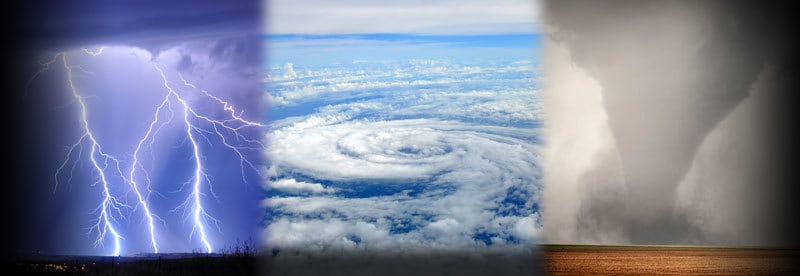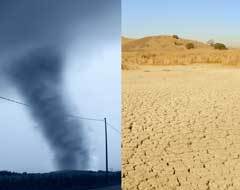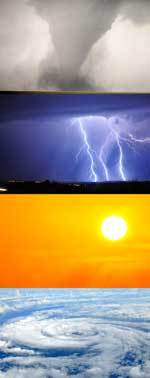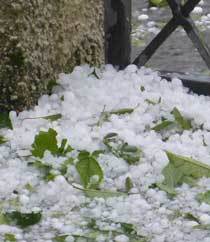The Most Dangerous Weather Conditions On Earth – What They Are And What Makes Them So Deadly

Many severe weather events can rightfully claim the title "Deadliest Weather Phenomenon." We take a closer look at the most dangerous weather conditions on the planet and what makes them so deadly.
As the previous paragraph stated, several weather phenomena can be regarded as the deadliest or most dangerous. This raises the questions as to what the most dangerous weather phenomenon in the world is. The answer is not that straightforward.
Determining the most deadly weather phenomenon on the planet mostly depends on time and scale. And depending on which criteria gets used, the outcome may vary dramatically.
For example, some atmospheric occurrences (e.g., hurricanes) are hundreds of miles in diameter and last for several days. Others (e.g., tornadoes) are less than a mile wide with a lifespan of fewer than 15 minutes.
As a result, there is more than one atmospheric condition that can claim the title of the deadliest weather phenomenon. This post demonstrates how it depends on the lens through which you view each occurrence and what factors you use to measure its impact.
The Most Deadly Weather Phenomenon
As the introduction eluded to, there is no clear-cut answer as to which meteorological occurrence can be regarded as the deadliest or most dangerous. Each one has to be viewed in the context of time and scale.
With this said, the following weather phenomena are arguably the most deadly weather occurrences as defined by their size, duration, and severity:
What Is The Most Deadly Weather Phenomenon On Earth?

In terms of immediate danger, destruction, and threat to lives, tornadoes are considered the most deadly weather phenomena. In terms of total fatalities measured over time, drought and flooding are by far the most deadly and devastating.
Although it is accurate and concise, one needs to properly unpack this summary to gain a thorough understanding of how and why these weather occurrences have such an impact on the environment and human lives.
As already mentioned, no one phenomenon can claim the title as the deadliest regardless of context. Depending on the scale, duration, and intensity of the occurrence, several weather conditions qualify as the most dangerous and destructive.
Dangerous weather conditions vary from occurrences a few feet to hundreds of miles in diameter and lasting from less than an hour to longer than a week.
The following list provides a clear and detailed explanation of the deadliest weather phenomena on the planet and the circumstances under which they occur.
List Of The Most Dangerous Weather Conditions
The weather phenomena in the following list are not all independent weather systems. Some are part of a larger storm system, some are the direct or indirect result of another weather occurrence, while others are completely self-contained weather systems.
Although they do not appear in any definitive order of importance, the atmospheric conditions that are generally accepted to be the most dangerous and destructive receive priority at the top of this list:

- Tornadoes
- Tropical Cyclones (Hurricanes, Cyclones, Typhoons)
- Lightning
- Extreme Heat
- Droughts And Flooding
- Hail
Each of these weather conditions proofs uniquely dangerous when we take a closer look at each phenomenon and view it within the context that they occur:
1) Tornadoes
They are not the biggest in size nor the most long-lasting, but tornadoes are by far the deadliest and most destructive weather phenomenon that occurs over a small area in a relatively short period.

They are not independent storms and are usually produced by massive thunderstorms called supercells. (The latter is commonly found in the Great Plains of the United States, where cold and warm air masses meet to develop these large-scale storm systems.)
The deadliest tornado in recent history occurred in Bangladesh in 1989 and resulted in approximately 1300 deaths.
What Makes A Tornado Dangerous
- A tornado can appear with very little or no warning, which leaves a very limited time to seek shelter. (The average tornado warning time is about 13 minutes.)
- 2Although it only lasts for approximately 10 minutes or less, the amount of energy released by a tornado during this period is unmatched by any other storm system.
- 3Wind, the primary force of this storm, can easily exceed 480 km/h (300 mph) in a tornado. This is powerful enough to flatten most structures in its path.
These factors combine to contribute to the devastation of structures and loss of life that occur over a short period of time. You can find more in-depth information about tornadoes in this article.
2) Tropical Cyclones (Hurricanes, Cyclones, Typhoons)
Moving up in scale and duration, few things come close to the destructive power of a tropical cyclone. With an average size of 200 miles in diameter and lasting for approximately six days, hurricanes are by far the deadliest and most destructive force on this scale.
("Tropical Cyclone" is the umbrella term used to describe hurricanes, typhoons, and cyclones. These storms are basically identical, with the only difference being the location where they occur, as well as their direction of rotation.)
Hurricanes and typhoons start as a small tropical depression over the warm waters of the Tropics. Over time it grows into a tropical storm, which eventually turns into a hurricane or typhoon under the right conditions.
The deadliest hurricane in recent history is Hurricane Mitch, which resulted in 11 374 deaths in 1998. It occurred in Central America in the regions of Honduras and Nicaragua.
What Makes A Tropical Cyclone Dangerous
- The most dangerous aspect of a tropical cyclone is the large-scale flooding that occurs as a direct result of heavy downpours. It is the leading cause of fatalities during and after a hurricane.
- 2The strong winds that accompany the storm systems can reach sustained speeds of over 260 km/h (161 mph). This enables them to cause damage in the outer bands but is especially destructive in the storm's eyewall.
- 3The sheer size of a cyclone results in widespread damage over an extensive area. Large regions get subjected to constant heavy rains and strong winds, which often leads to individuals being trapped in place and unable to get out of harm's way.
- 4The "eye of the storm" is a unique feature of hurricanes that makes them especially dangerous. It is a deceptively calm, cloudless area in the center of the storm that creates a false sense of security and causes residents to leave their shelters.
- 5Damage and fatalities as a result of a hurricane sometimes only materialize days (in some cases weeks) after the actual storm already passed. For example, water from high-lying regions can take days to reach valleys and cause widespread flooding.
Tropical cyclones are complex storm systems that require a complete and separate article to grasp a better understanding of how it functions. You can find more in-depth information about tropical cyclones/hurricanes in this article.
3) Lightning
They may not cause as many fatalities and damage as tornadoes and hurricanes, but lightning is uniquely dangerous. Its unpredictability and the power with which they hit make a lighting strike deadly to humans and animals.

It is hard to get a precise number, but lightning is responsible for roughly 24 000 annual fatalities worldwide. In the United States, a relatively "underwhelming" number of 51 yearly deaths get reported.
These figures may create the impression that lightning is less deadly than it really is, which will be a wrong and very dangerous assumption.
The worst incidents of lightning damage & deaths are caused by secondary events. One of the deadliest lightning strikes in history occurred when a church in Brescia, Italy, was struck in 1769. It ignited 90 tonnes of gunpowder, killing 3 000 people and destroying half the city.
What Makes Lightning Dangerous
- Lightning is essentially a massive electrical discharge, able to generate up to 100 million volts. As a result, even if a human or animal suffers an indirect lightning strike, it is still more than powerful enough to kill or cause severe injuries.
- 2Lightning bolds also reach extremely high temperatures of up to 27 700° Celsius (50 000° Fahrenheit.) This can lead to serious burn injuries & fatalities but is also responsible for starting deadly fires in urban and rural areas.
- 3The unpredictability and speed with which a lightning strike occurs make it especially dangerous. Although thunderstorms are predicted with a fair amount of accuracy, an actual lightning strike occurs without warning within milliseconds.
- 4Lightning strikes are not confined to thunderstorms. They also form part hurricanes, occur during volcanic eruptions, and are even produced during large forest fires.
For lightning to occur, the right atmospheric conditions need to be in place, which justifies a more elaborate explanation that falls outside the scope of this article. You can find more in-depth information about lightning in this article.
4) Extreme Heat
Surprisingly, one of the deadliest phenomena that go by almost entirely unnoticed right in front of our eyes is extreme heat. One of the reasons this silent killer occurs almost unnoticed is as a result of the time over which it occurs and the absence of warning signs.
"Heatwaves are responsible for more human deaths per year than any other weather event"

For example, the heatwave that struck Europe in 2003 resulted in around 70 000 deaths. In 2010, the Siberian Heatwave that lasted 44 days caused 56 000 deaths in Russia. Finally, more than 600 people die each year in the United States alone due to heat-related illnesses.
Conditions are classified as a heatwave when unusually hot temperatures persist for two days or longer. These types of events are on the increase largely as a result of global warming. It is no surprise then that extreme heat and drought go hand-in-hand.
(Both are the result of extended periods of solar radiation, as well as the prolonged absence of cold and wet atmospheric conditions.)
What Makes Extreme Heat Dangerous
- A heatwave doesn't occur suddenly, but builds up over several days and can last for over a week. Its deadly impact slowly takes its toll on both human and animal health with fatal consequences.
- 2Extreme heat does not have an early warning system in place compared to those developed for dangerous weather occurrences like hurricanes, lightning, and tornadoes.
- 3The relative quiet and uneventfulness that accompanies a heatwave, combined with little awareness of the immediate danger, allow it to do most of its damage without much notice.
- 4As more people move to urban environments like cities and other metropolitan areas, the Urban Heat Island Effect contributes and exasperates the effect of an already rapidly warming planet.
Extreme heat should not be viewed in isolation, as it is usually part of a more extensive system and closely linked to global climate trends. It usually takes the form of a heatwave, of which you can find more detailed information in this article.
5) Droughts And Flooding
The leading cause of human fatalities, measured over an extended period and regardless of scale, is droughts & flooding. Although neither are independent meteorological phenomena, they both occur as a result of the presence or absence of specific weather conditions.

For example, as a result of climate change, a rise in global temperatures combined with the extended absence of rainclouds are causing certain parts of the world to experience extreme droughts.
Similarly, the heavy rain that occurs during and after large storms like tropical cyclones and monsoons can lead to largescale & widespread flooding in valleys & other low-lying regions.
Of the two, drought is by the most deadly, with food shortages causing entire countries and vast regions to experience severe famine. In 1922, China experienced the worst drought in recorded history, with a death toll of 3 million human lives.
(This drought is closely followed in severity by the Bengal famine of 1943, which claimed 1.9 million lives in Bangladesh, as well as the twin droughts that struck India in 1965 and resulted in 1.5 million fatalities.)
Flooding is not as deadly as droughts in terms of total numbers but are also responsible for a large number of deaths due to drowning and food shortages. China again fell victim in 1887 with the Yellow River Flood, resulting in an estimated 900 000 - 2 million deaths.
What Makes Drought And Flooding Dangerous
- Since all life on the planet depends on water, drought affects everything. Famine, a direct consequence of drought, are one of the leading cause of death in developing countries. (Developed countries are not exempt from the effects of drought!)
- 2Flooding that occurs as a result of a hurricane, monsoon, or another large storm, do not necessarily take place at the same time or location as the original event. It can happen days later, at a much larger scale, and at a distant location.
- 3The strength of the volume of moving water during flooding is especially deadly. Not only do low water levels create a false sense of security, but its ability to weaken and destroy structures adds an additional layer of danger to human life.
- 4Drought also has a severe economic impact that can be more destructive than drowning or food shortage. Extended periods of drought can cripple entire economies and destroy the livelihood of people involved in the agriculture sector.
To illustrate the economic impact of drought mentioned in this last point, it is worth noting that in the United States alone, annual losses due to this phenomenon are approaching the 9 billion dollar mark. It is easy to see how this will result in serious financial hardship.
6) Hail
Hail is not an independent weather system but forms part of thunderstorms where the updrafts in cumulonimbus clouds are responsible for the formation of hailstones. It is also a direct result of a thunderstorm, which makes it easier to calculate its immediate impact.

As a result of its visually striking physical attributes and familiarity among the general public, the real danger that a hailstorm pose is generally slightly exaggerated. This does not mean that it poses no threat, but it is not as deadly as commonly perceived.
Exactly how deadly hail is, mostly depends on the size of hailstones. It can vary in size from as small as a pea to the size of a grapefruit. The bigger the size of the hailstone, the more deadly and destructive a hailstorm will be.
The average size of a hailstone varies from 2.5 - 4.4 cm (1 - 1.73 inches) in diameter. Once the size exceeds 2 cm (0.80 inches), it starts to cause notable damage. Hailstones the size of grapefruits (10 cm or 4 inches) are considered very dangerous and deadly.
However, it is important to note that hail the size of grapefruits or tennis balls occurs very rarely, and the vast majority of hailstorms are harmless.
The deadliest hailstorm in history occurred close to Moradabad, India. Hailstones reportedly reached the size of goose eggs (7 - 11 cm or 3 - 4.5 inches) and killed 246 people on 30 April 1988.
The largest hailstone ever documented was 20 cm (8 inches) in diameter. It fell in South Dakota, United States, in 2010. To put it in context, it was the size of a volleyball and just under 2 pounds in weight.
What Makes Hail Dangerous
- Apart from the size and frequency of hail, the speed with which hailstones fall can make them deadly. Wind speeds can increase the velocity of a hailstorm and turn otherwise small & harmless stones into lethal projectiles.
- 2The abruptness with which hailstones fall without any or little warning makes it hard to shelter in time. Although hail is associated with large thunderstorms, it is hard to pinpoint where and when it will take place.
Hailstorms are not independent weather phenomena but form part of large thunderstorm systems with strongly developed updrafts. You can learn more about hail in this article.
Conclusion
As this article clearly illustrated, there is no clear weather phenomenon that can be considered the most deadly. It all depends on the size, severity, and scale of the event.
For example, nothing can compare to the destructive power of a tornado on a relatively small scale and duration. Move up to several hundred miles in size and measured over days, the strength and danger of a large hurricane are unmatched.
This article highlighted the most deadly weather phenomena on the planet, as well as the circumstances under which they occur.
Never miss out again when another interesting and helpful article is released and stay updated, while also receiving helpful tips & information by simply following this link .
Until next time, keep your eye on the weather!
